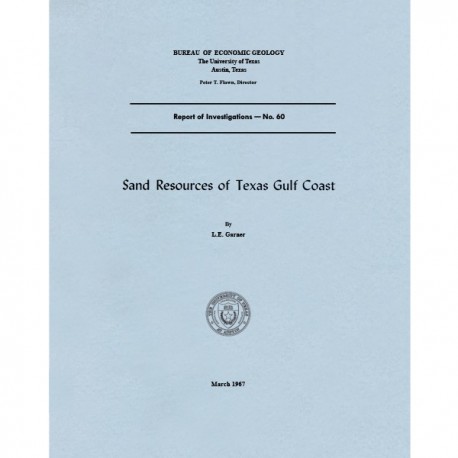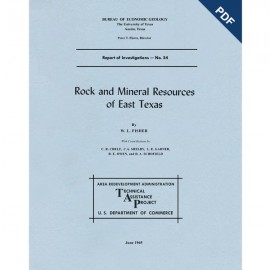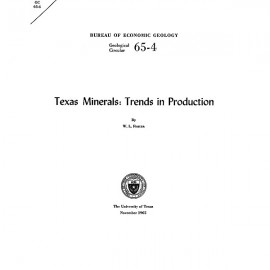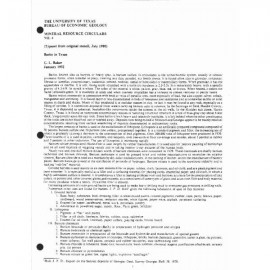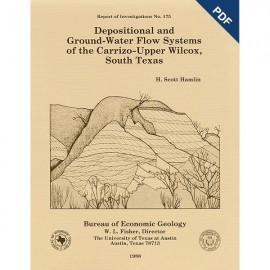Reports of Investigations
-
Books & Reports
- Reports of Investigations
- Guidebooks
- Udden Series
- Geological Circulars
- Down To Earth
- Atlases of Major Oil and Gas Reservoirs
- Texas Memorial Museum Publications
- Environmental Geologic Atlas of the Texas Coastal Zone
- Mineral Resource Circulars
- Other Reports
- Seminars and Workshops
- Handbooks
- Submerged Lands of Texas
- Symposia
- Annual Reports
- Open File Reports
-
Maps & Cross Sections
- Thematic Maps
- Miscellaneous Maps, Charts & Sections
- Geologic Atlas of Texas
- STATEMAP Project Maps
- Geologic Quadrangle Maps
- Cross Sections
- Highway Geology Map
- Energy and Mineral Resource Maps
- Shoreline Change and Other Posters
- Wilcox Group, East Texas, Geological / Hydrological Folios
- Bouguer Gravity Atlas of Texas
- River Basin Regional Studies
- Featured Maps
- Posters
- Teachers & the Public
-
Geological Society Publications
- Gulf Coast Association of Geological Societies
- Alabama Geological Society
- Austin Geological Society
- Corpus Christi Geological Society
- Houston Geological Society
- Lafayette Geological Society
- Mississippi Geological Society
- New Orleans Geological Society
- South Texas Geological Society
- GCS SEPM Publications
- Historic BEG & UT Series
Sand Resources of Texas Gulf Coast
RI0060
Sand Resources of Texas Gulf Coast, by L. E. Garner. 85 p., 12 figs., 6 plates, including 1 map, 1967. ISSN: 0082335X: Print Version.
A free, digital version of this publication can be found on: Texas ScholarWorks
RI0060. Sand Resources of Texas Gulf Coast, by L. E. Garner. 85 p., 12 figs., 6 plates, including 1 map, 1967. ISSN: 0082335X: Print.
To purchase this publication as a downloadable PDF, please order RI0060D.
ABSTRACT
This report deals with the occurrence and potential production of industrial sand in the Gulf Coast area of Texas. The study area covers approximately 23,000 square miles underlain by alluvial, deltaic, beach, and eolian deposits of Pleistocene and Recent age. Deposits are intermixed and interbedded sands, gravels, silts, and clays. Sand bodies are irregular in size and shape depending on environment of deposition; they vary in physical character and mineralogical and chemical composition. Pleistocene sand deposits along the Texas Gulf Coast occur in the Willis, Lissie, Montgomery, and Beaumont Formations which underlie regional coastwise terraces or erosional surfaces. Recent deposits include those currently being deposited along the modern coast and major streams.
The report includes Aransas, Austin, Brazoria, Calhoun, Cameron, Colorado, Chambers, Fort Bend, Galveston, Harris, Hardin, Hidalgo, Jackson, Jefferson, Kleberg, Kenedy, Liberty, Matagorda, Nueces, Orange, Refugio, San Patricio, Victoria, Wharton, Waller, and Willacy counties. There is current industrial sand production within this area in Columbus, Hardin, and Liberty counties. A few other sand deposits have a relatively low content of iron oxide and suitable grain size, but most deposits require beneficiation to meet specifications for industrial use. Most counties have some constructional sand or gravel production.
Keywords: sand, Texas Coastal Zone, Texas, Pleistocene, mineral resources, sand and gravel
Citation
Garner, L. E., 1967, Sand Resources of Texas Gulf Coast: The University of Texas at Austin, Bureau of Economic Geology, Report of Investigations No. 60, 85 p.
